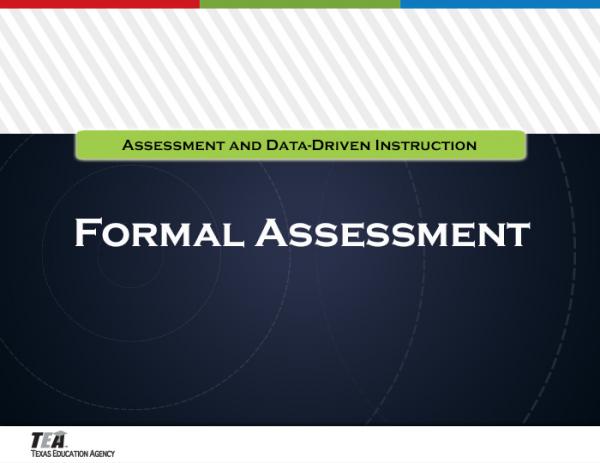Formal Assessment
Criteria for Formal Assessments
The criteria for formal assessments is more explicit than the criteria for informal assessments. Generally, formal assessments
have specific administration procedures and time limits,
have test administrators who may have completed credentialing or training requirements, and
have data that has been validated and tested on groups for which the assessment was designed.
Designs for Formal Assessments
There are two standard ways of designing a formal assessment in order to appropriately evaluate students’ results: norm referencing and criterion referencing (Huitt, 1996).
| Norm-Referenced | Criterion-Referenced | |
|---|---|---|
|
Purpose |
Rank each student with respect to the achievement of others in broad areas of knowledge |
Determine whether each student has achieved specific skills or concepts |
|
Content |
Measures broad skill areas sampled by a variety of textbooks, syllabi, and the judgments of curriculum experts |
Measures specific skills that make up designated curriculum skills (These skills are expressed as an instructional objective as identified by curriculum experts or educators.) |
|
Item Characteristics |
Each skill is usually tested by less than four items. The items vary in difficulty. |
Each skill is tested by at least four items in order to obtain an adequate sample of student performance and to minimize the effect of guessing. |
|
Score Interpretation |
Each individual is compared with other examinees. A student’s score is usually expressed as a percentile, a grade equivalent, or a stanine (a score according to a nine-point scale). Student achievement is reported for broad skill areas, although some norm-referenced tests report achievement for individual skills. |
Each individual is compared with a preset standard for acceptable achievement. The performance of other examinees is irrelevant. A student’s score is usually expressed as a percentage. Student achievement is reported for individual skills. |
State Assessments
In order to comply with requirements for formal assessments, which are also referred to as standardized assessments, the State of Texas provides the State of Texas Assessments of Academic Readiness (STAAR®) and the Texas English Language Proficiency Assessment System (TELPAS).
An additional formal assessment required within Texas public schools is the Oral Language Proficiency Test (OLPT), which measures a student's English proficiency.
STAAR
Beginning in spring 2012, students were assessed with STAAR, which replaced the Texas Assessment of Knowledge and Skills (TAKS). The STAAR assessments emphasize “readiness” standards and are aligned with the Texas Essentials Knowledge and Skills (TEKS), the state standards for what students should know and be able to do.
For more information about the STAAR assessment, visit the Texas Education Agency STAAR Resources web page.
TELPAS
The Every Student Succeeds Act of 2016 (ESSA), requires states to annually assess the progress of K–12 ELLs in four language domains: listening, speaking, reading, and writing.
The State of Texas does this with the Texas English Language Proficiency Assessment System (TELPAS), which is aligned with the ELPS Cross-Curricular Student Expectations. TELPAS meets the federal requirement of evaluating the progress that ELLs make in becoming proficient in the use of academic English.
Review the Cross-Curricular Student Expectations on p. 21 of the ELPS Resource Supplement.
It is important to note that STAAR and TELPAS are both standards-based and assess student performance on specific knowledge and skills. Remember, standards-based instruction and assessments work in conjunction to increase students’ English language proficiency and academic achievement.
These accountability measures are put into place to ensure that ELLs are provided equitable resources and support to meet rigorous and challenging standards in all content areas.
TELPAS Composite Score
TELPAS assesses the English language proficiency of K–12 ELLs in four language domains: listening, speaking, reading, and writing. TELPAS meets the federal requirement for evaluating ELLs' annual progress in becoming proficient in academic English.
For Grades 2–12, a student's TELPAS composite score includes
- a multiple-choice reading test,
- a holistically-rated writing collection, and
- holistically-rated listening and speaking assessments.
Proficiency Level Descriptors (PLDs) define the stages of second language acquisition. There are separate PLDs for listening, speaking, reading, and writing. The listening and speaking assessments are based on ongoing classroom observations and student performance in daily interactions while referencing the PLDs.
Preparing for TELPAS
In preparation for the TELPAS performance-based assessments, ELLs should have multiple opportunities to participate in a variety of academic tasks. ELLs should be familiar with and comfortable in instructional tasks that involve all four language domains: listening, speaking, reading, and writing.
ELLs should participate in frequent, targeted academic tasks that promote language development and content attainment. These tasks should
involve real-world contexts;
focus on “big ideas” and major concepts rather than isolated facts and definitions;
encourage collaboration and communication;
present students with open-ended problems; and
correlate content, process, group, and communication skills.
Oral Language Proficiency Test (OLPT)
The OLPT is also considered a formal assessment. Texas Administrative Code §89 requires that an OLPT be administered for students’ identification, entry, and/or exit from Bilingual/ESL programs. While there are several types and forms of OLPTs, all of them measure students’ listening and speaking skills. Each type or form of OLPT has its own scale score.
For additional information on the TEA-approved OLPTs and other formal assessments for ELLs, go to the Texas Education Agency Bilingual/ESL Education page.












